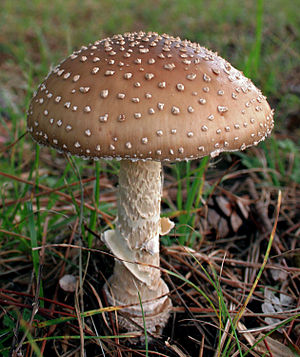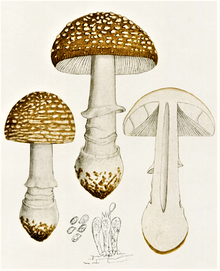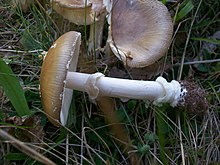Panther mushroom
| Panther mushroom | ||||||||||||
|---|---|---|---|---|---|---|---|---|---|---|---|---|

Panther mushroom ( Amanita pantherina ) |
||||||||||||
| Systematics | ||||||||||||
|
||||||||||||
| Scientific name | ||||||||||||
| Amanita pantherina | ||||||||||||
| ( DC .: Fr. ) Krombh. |
The Panther mushroom ( Amanita pantherina ) is a species of fungus from the family of Wulstlingsverwandten (Amanitaceae). The fruiting bodies of the panther mushroom show typical amanitae features: brown hats covered with white flakes, ringed white stems with a thickened bulb at the lower end and light, densely standing lamellae. The panther mushroom is highly poisonous. The fruit bodies contain ibotenic acid , muscimol and muscazone .
features

Macroscopic features
The nominate form of the panther mushroom is characterized by fruiting bodies with spread out, flat brown hats and slender white stems. The hats are 4–10 cm wide and have a greasy skin when the weather is wet and glossy when the weather is dry. The white flakes, which are remnants of the velum and are arranged concentrically around the middle of the hat, are particularly characteristic . They are easily washed off in the rain, so older specimens usually show a thinned flake pattern. The upper skin of the hat is removable, its color varies from dark brown to white-brown, the edge is usually grooved. In young fruiting bodies, the hat still has a spherical shape, but spreads out flat with age. The lamellae are white, soft and close together.
The stalk of the panther mushroom is 6–12 cm high and has a diameter of 0.5–2 cm. It is white, delicately flaky and fibrous inside, hollow in old specimens. The panther mushroom has a slender tuber at the base of the stem. It is characteristically edged and sharply set off with a bulge. The association with a foot in a sock gave this feature the colloquial term "mountaineering sock". One or more ring-shaped belt zones are indistinctly visible above it. The cuff sits in the middle or just a little higher on the handle and therefore has no grooves as impressions of the lamellar cutting edges (exceptions can occur). In the case of young fruiting bodies, it usually protrudes, but becomes more limp with age and finally lies on as a thin ring. The white flesh is fragile. It smells slightly like radish , but tastes slightly sweet.
Microscopic features
Like all amanita relatives , the panther mushroom has a monomitic trama of exclusively generative, thin-walled hyphae . The basidia are four-pore, the spores themselves are inamyloid .
Species delimitation
The edible gray amanita ( Amanita excelsa ) can be very similar due to a similar color and difficult to distinguish for inexperienced collectors. It differs in the larger, flat-fitting remains of velum on the hat, which are darker gray-brown in color, a thicker, non-ring-shaped stem bulb and a larger and longer-lasting cuff with clear grooves (longitudinal stripes), which is attached directly under the middle of the hat. In addition, it is overall stronger and stockier, the hat is dreary gray-brown in color and usually has an unrubbed edge.
It can also be confused with the pearl mushroom ( A. rubescens ), which is often collected and valued as an edible mushroom . The pearl mushroom, like the gray amanita, differs from the panther mushroom in that it has a stronger stature, more flat, grayish remains of velum, a mostly unrubbed hat rim and a grooved ring, but it can also be easily distinguished by its red tones. Feeding tunnels or injuries in the flesh as well as the hat have flesh-pink, orange or reddish-brown tones, which the panther mushroom lacks. In addition, the pearl mushroom does not smell like radish.
Light forms of the panther mushroom can be confused with the closely related and also poisonous daffodil yellow amanita ( A. gemmata ). But it has wax to yolk yellow hat colors.
Brown forms of toxic fly agaric ( A. muscaria ) and the king mushroom ( A. regalis ) are distinguished by the lack of belt areas for occupied with warty flakes tuber and in section by a yellow line of the pileus.
The porphyry brown amanita ( A. porphyria ) differs through other, more violet-brown colors and flat velum remains, which hardly contrast with the color of the hat, as well as through a different bulbous shape. The rare Rauhe Amulstling ( A. franchetii ) is distinguished by its pointed, yellowish flakes on the hat, ring and bulb, the latter is also not set off in a bulge.
ecology
Panther mushrooms are mycorrhizal partners of deciduous and coniferous trees and occur in a variety of different forest forms. The fruiting bodies appear between June and November.
distribution
The panther mushroom is widespread in the Holarctic .
toxicity
Like the fly, the panther mushroom was also used by the Siberian peoples for initiation rites. The poisonous ibotenic acid in the mushroom is converted into muscimol during the drying process , which is supposed to be very effective but not as poisonous. The deadly amount of poison is contained in more than 100 grams of fresh mushroom. Due to the strongly fluctuating active ingredient content, this value should only be understood as a guide value. The lethal dose of ibotenic acid is 38 mg per kg of body weight.
One to two hours after eating the mushroom and the associated poisoning , nausea, diarrhea and vomiting occur, the skin reddened and the pupils dilated. Then a transition to states of excitement and intoxication becomes noticeable, seizures and confusion can also occur. Depending on the amount of mushroom ingested, a coma or death from respiratory paralysis can rarely occur.
For treatment, the stomach is emptied, provided that it was not consumed too long ago. To bind the toxins, activated charcoal is administered and the intestine is emptied by the administration of laxatives in order to remove the fungal residues from the intestines and to prevent the absorption of even more poison. Anti-spasms are given anti-spasmodic drugs that calm the agitated states ( e.g. benzodiazepines ). To stimulate the kidneys and “flush” the blood, an infusion with isotonic saline solution can be applied.
6.6% of all mushroom poisoning is caused by the panther mushroom. The death rate is one to two percent.
swell
literature
- René Flammer, Egon Horak: Poison mushrooms - mushroom poisons. Mushroom poisoning . A reference work for doctors, pharmacists, biologists, mycologists, mushroom experts and mushroom pickers. Schwabe, Basel (CH) 2003, ISBN 978-3-7965-2008-2 (204 pages).
- Lutz Roth, Hanns Frank, Kurt Kormann: Poisonous mushrooms, mushroom poisons . Molds - Mycotoxins - Occurrence - Ingredients - Fungal allergies - Food poisoning. Nikol, Hamburg, ISBN 978-3-933203-42-7 (328 pages).
- German Josef Krieglsteiner (Ed.), Andreas Gminder : Die Großpilze Baden-Württemberg . Volume 4: Mushrooms. Blattpilze II. Ulmer, Stuttgart 2003, ISBN 3-8001-3281-8 .
Individual evidence
- ↑ Panther mushroom. Drug Scouts, accessed June 10, 2017 .
- ↑ a b GEO topic lexicon: Medicine and health: diagnosis, healing arts, medicines; Part 3 / Volume 11 ISBN 3-7653-9431-9
- ↑ Roth, Frank, Kormann, 1990
Web links
- Psychoactive amanitas . In: Erowid . (English)

